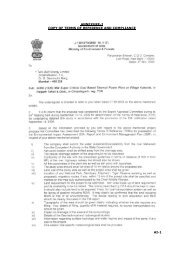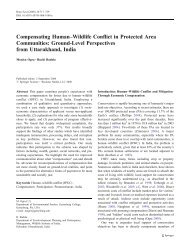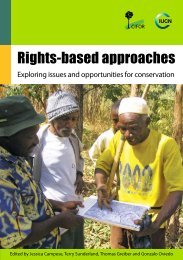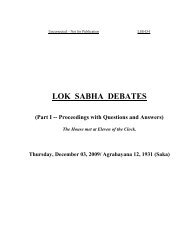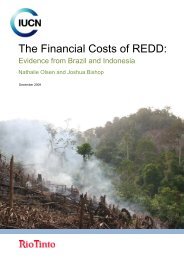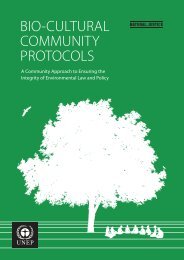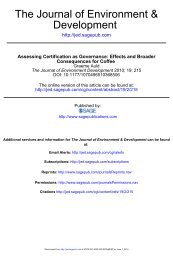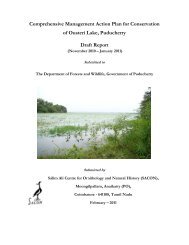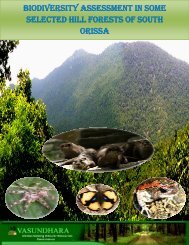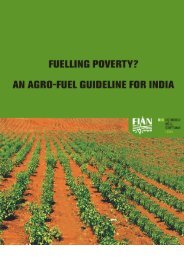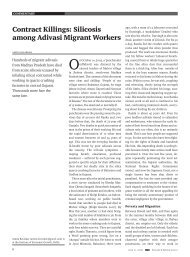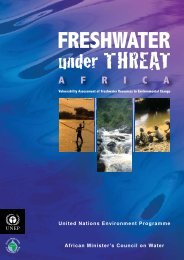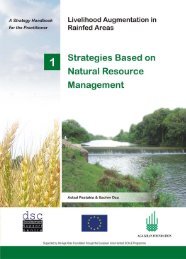Integrated River Basin Planning – Replicable ... - India Water Portal
Integrated River Basin Planning – Replicable ... - India Water Portal
Integrated River Basin Planning – Replicable ... - India Water Portal
Create successful ePaper yourself
Turn your PDF publications into a flip-book with our unique Google optimized e-Paper software.
<strong>Integrated</strong> <strong>River</strong> <strong>Basin</strong> <strong>Planning</strong>: <strong>India</strong> and the EU share experience on policy and practice<br />
<strong>Water</strong> Policy, Legislation, Management and Institutions in Kerala<br />
state in the form of lift irrigation schemes, improvement of existing lakes and<br />
ponds, diversion schemes for natural streams, prevention of salinity intrusion<br />
in rivers, drainage works to paddy fields, construction of check dams, vented<br />
cross bars and sluices. Construction of sea walls, flood damage control works<br />
including side protection works of natural streams and channels, etc. are other<br />
major areas of activities under the Irrigation Department. <strong>River</strong> water comes under<br />
the jurisdiction of the Irrigation Department as well.<br />
5.2.4 Kerala State Pollution Control Board<br />
The Kerala State Pollution Control Board is entrusted with the responsibility<br />
of controlling pollution, restoring and maintaining the wholesomeness of the<br />
environment and implementation of statutes aimed at protecting the environment<br />
in the State. It also advises the State Government on all matters concerning<br />
prevention, control or abatement of pollution. Regarding water quality monitoring,<br />
the Kerala SPCB is carrying out two major schemes: the National Ambient <strong>Water</strong><br />
Quality Programme (NWMP) at 64 stations and the State Ambient <strong>Water</strong> Quality<br />
Programme at 119 stations in 21 rivers. Digitization of data has started. The<br />
department also keeps geo-referenced records of data. They provide data to the<br />
CPCB for environmental management.<br />
The intention is that the Authority will formulate policies and projects for<br />
sustainable development of water resources and river basins of the Pamba <strong>River</strong>,<br />
and for scientific management to protect the area’s ecosystems and its genetic<br />
variety and biodiversity. It has the power to impose control or restrictions over<br />
the exploitation of natural resources or encroachment that have an impact on the<br />
water resources and the basin of the Pamba <strong>River</strong>.<br />
At present, the Irrigation Department is the main functionary for the Pamba <strong>River</strong><br />
<strong>Basin</strong> Authority.<br />
The members represented in the Authority represent various sectors of the GOK,<br />
ranging from the irrigation department, to forestry, health, sanitation, as well as<br />
the local self government. A simplified organogram of the PRBA is provided in<br />
Figure 9.<br />
Figure 9 Organogram of the Pamba <strong>River</strong> <strong>Basin</strong> Authority<br />
Chair Person<br />
(Chief Minister)<br />
For the Pamba <strong>River</strong>, data is being collected mainly in the downstream area.<br />
The Pamba <strong>River</strong> flows through Pathanamthitta, Thiruvalla, Kuttanadu and<br />
Ambalappuzha and finally falls into Vembanad Lake. The monitoring stations are<br />
located at Parumala, Chenganoor and Thakazhy for trend analysis. Monitoring<br />
frequency is done quarterly for these locations.<br />
5.2.5 Pamba <strong>River</strong> <strong>Basin</strong> Authority<br />
On the basis of the water quality data of the State Pollution Control Board and<br />
the severity of environmental problems in the Pamba <strong>Basin</strong>, an Action Plan<br />
was prepared by the State and approved by the MoEF for reducing the level of<br />
pollution in Pamba <strong>River</strong>. However, this document does not address other issues<br />
affecting the Pamba <strong>River</strong>. The Ministry of <strong>Water</strong> Resources took the initiative for<br />
the formation of the Pamba <strong>River</strong> <strong>Basin</strong> Authority (PRBA) for the implementation<br />
of the Action Plan. PRBA has 15 members and is chaired by the chief minister.<br />
The water resources minister is its vice-chairman. The water resources secretary<br />
is member secretary. Other members include secretaries of various departments<br />
such as revenue, forest, local self-government, health, science and technology<br />
and environment, finance, power and Devaswom. The chairman of the Kerala<br />
State Pollution Control Board is also a member. Two water sector experts have<br />
been nominated by the government to the Authority.<br />
Director<br />
Members<br />
1, 2, 3 4 and 5<br />
Vice Chair Person<br />
(Minister of WR)<br />
Member Secretary<br />
(Secretary of WR)<br />
Members<br />
6,7,8,9 and 10<br />
The Pamba <strong>River</strong> <strong>Basin</strong> Authority Bill (2009) established an authority in the state<br />
as a statutory body for the conservation of water resources in the Pamba <strong>River</strong><br />
and its basin as an integral unit. According to the Bill’s Preamble,<br />
the government is bound to ensure the quality of water in the river and to<br />
take measures to prevent pollution and to undertake integrated planning,<br />
monitoring, management and development of water resources in the river<br />
with the river basins as an integral unit.<br />
38 39



